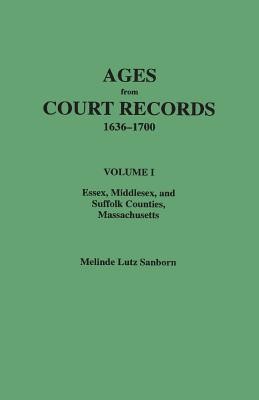
- We will send in 10–14 business days.
- Author: Melinde Lutz Sanborn
- Publisher: Genealogical Publishing Company
- ISBN-10: 0806317205
- ISBN-13: 9780806317205
- Format: 14 x 21.6 x 1.2 cm, softcover
- Language: English
- SAVE -10% with code: EXTRA
Ages from Court Records, 1636-1700. Volume I (e-book) (used book) | bookbook.eu
Reviews
Description
From thousands of court cases in Essex, Middlesex, and Suffolk Counties, Massachusetts, dating from 1636 to 1700, Melinde Sanborn has extracted the names of all deponents and witnesses whose ages are given in the court records of those counties. Depositions provided in early court records are among the richest sources of personal information surviving from New England's first century, and Ms. Sanborn argues that "so many people in early New England were deponents for one reason or another that no biography or genealogy can be complete without a search through court records to see if a pertinent deposition exists." For this early period, the single most useful bit of evidence included in the depositions is the age of the deponent. While most depositions vary in quality from being virtually useless to providing corroboration of marriages, wills, and deeds, ages alone provide incontrovertible value to the genealogist. Sometimes the age of a deponent was very important to a particular case. Men over sixty, for example, were often brought into court to support the claims of the ancient boundaries of litigants' property. Likewise, many older women who were experienced midwives were called upon to offer opinions on the timeliness of a birth in a fornication case. Also, one of the most common errors in genealogical work is confusing two or more individuals of the same name. If senior or junior or tertius is not used, it is very difficult to assign events to the correct individual. Frequently, fathers and sons with the same given name came to court together, but with stated ages they are easily differentiated. Men with the same name and of the same generation can be another problem, but again a deposition with a specific age given can make all the difference. With this index--which lists the names and ages of 11,000 deponents, and the year and source of the court records--researchers can quickly determine whether it is worthwhile to track down the original court record.
EXTRA 10 % discount with code: EXTRA
The promotion ends in 16d.21:54:32
The discount code is valid when purchasing from 10 €. Discounts do not stack.
- Author: Melinde Lutz Sanborn
- Publisher: Genealogical Publishing Company
- ISBN-10: 0806317205
- ISBN-13: 9780806317205
- Format: 14 x 21.6 x 1.2 cm, softcover
- Language: English English
From thousands of court cases in Essex, Middlesex, and Suffolk Counties, Massachusetts, dating from 1636 to 1700, Melinde Sanborn has extracted the names of all deponents and witnesses whose ages are given in the court records of those counties. Depositions provided in early court records are among the richest sources of personal information surviving from New England's first century, and Ms. Sanborn argues that "so many people in early New England were deponents for one reason or another that no biography or genealogy can be complete without a search through court records to see if a pertinent deposition exists." For this early period, the single most useful bit of evidence included in the depositions is the age of the deponent. While most depositions vary in quality from being virtually useless to providing corroboration of marriages, wills, and deeds, ages alone provide incontrovertible value to the genealogist. Sometimes the age of a deponent was very important to a particular case. Men over sixty, for example, were often brought into court to support the claims of the ancient boundaries of litigants' property. Likewise, many older women who were experienced midwives were called upon to offer opinions on the timeliness of a birth in a fornication case. Also, one of the most common errors in genealogical work is confusing two or more individuals of the same name. If senior or junior or tertius is not used, it is very difficult to assign events to the correct individual. Frequently, fathers and sons with the same given name came to court together, but with stated ages they are easily differentiated. Men with the same name and of the same generation can be another problem, but again a deposition with a specific age given can make all the difference. With this index--which lists the names and ages of 11,000 deponents, and the year and source of the court records--researchers can quickly determine whether it is worthwhile to track down the original court record.


Reviews